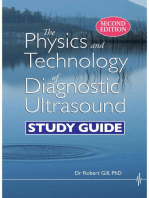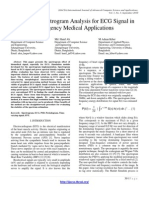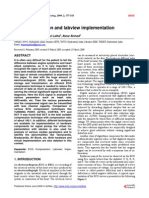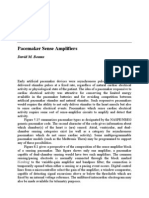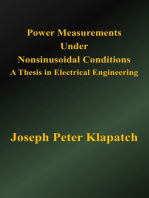April 2008
April 2008
Uploaded by
lvrevathiCopyright:
Available Formats
April 2008
April 2008
Uploaded by
lvrevathiOriginal Description:
Copyright
Available Formats
Share this document
Did you find this document useful?
Is this content inappropriate?
Copyright:
Available Formats
April 2008
April 2008
Uploaded by
lvrevathiCopyright:
Available Formats
APRIL/MAY 2008 PART A:
1}Conduction velocity range in nerves: The conduction velocity varies in nerves depending on the type and diameter of the nerve fiber and is from 20 to 140 m/s. But in heart muscle it is very slower range from 0.2 to 0.4m/s. 2}Passive transducer: i}Resistive transducer ii}Inductive transducer iii}Capacitive transducer 3}ERG: Eectro retinogram is for interpreting the electrical activity of the eye.This is for diagnosing neurological disorders & to find the level of anaesthesia. 4}Need for preamplifier: Refer key for weekly test question III{quest.no.2} 5}Need for earthing of medical instruments: many devices have a metal chasis and cabinet that can be touched by the medical attendantand patients. If they are not grounded there an insulation failure or short circuit results and leads to
6}Use of plethysmography:
To measure the total lung capacity(TCL),the pneumotachograph cannot be used since the residual volume of air left in the lung after a force exhaling cant be detected,. To measure TCL, the body plethysmograph is used. 7}Macroshock: A physiological response to a current applied to the surface of the body that produces unwanted or unnecessary stimulation like muscle contraction or tissue injury is called macroshock. Microshock: A physiological response to a current applied to the surface of the heart that results in unwanted stimulation like muscle contractions or tissue injury is called microshock. 8}Need for image intensifier in an X-ray machine: the X-ray image is created with the high density high contrast and high sharpness on film. The density or darkness of the image is proportional to the amount X-ray that penetrate the film. Contrast is a measure of the darkness of a desired image compared to its surroundings. 9}Defibrillator: A defibrillator is an electronic device that creates a sustained myocardial depolarisation of a patients heart in order to stop ventricular fibrillation or atrial fibrillation. 10}Dialysis:
Hemo dialysis
Peritonial dialysis
PART B:
11}a)i)
An action potential (or nerve impulse) is a transient alteration of the transmembrane voltage (or membrane potential) across an excitable membrane in an excitable cell (such as a neuron or myocyte) generated by the activity of voltage-gated ion channels embedded in the membrane. The best known action potentials are pulse-like waves of voltage that travel along the axons of neurons.
[1
11}a)ii)
Piezo electric transducer: When certain crystals subjected to compression or tension charge separation occurs in these crystals and an electrical voltage is developed. This is called piezo electric effect. Thus the piezoelectric type transducers convert displacement or pressure into an electrical variable. If we apply the dynamical pressure along the mechanical axis(y-axis) of the transducer, then an a.c. electrical v is induced along the electrical axis(x-axis ) of the transducer. piezoelectric effect is reversible. Inductive transducer: inductive transducer are based on the principle of charge in the reluctance, Permeability,no.of.turns in the coil and orientation of the coil which may produce a change in the L or mutual inductance of the transducer.
Nno.of.turns in the coil effective permeability of the medium in and around the coil Aarea of cross section of the coil l length of the coil Ggeometric form factor(A/l) Rreluctance of the coil 11}b)i)Cardiovascular circulation: In an intact heart,venous or unoxygenated blood is returned to the right side of the heart at a pressure 11}b)ii) Ultrasonic transducer: Ultrasonic waves are the nonaudiable sound waves whose frequencies are greater than 20000HZ. Ultrasonic waves are very useful for diagonstic and therapeutic applications. 12}a)i)Refer Nov\Dec 2007 question(12)a)1) ii)Refer Nov\Dec 2007 question(12)a)ii) 12)}b)i)Refer Nov\Dec 2007 question(12)b)i) b)ii)Refer Nov\Dec 2007 question(12)b)ii) 13}a)i)Refer key for second cycle test question(7(a)) ii)Refer key for second cycle test question(7(b)) 13}b) Gas analysis: Gas analysis are used tp determine the quantitative composition of inspired and expired gas and to assess the lung function. i}infrared gas analysers ii}paramagnetic oxygen analysers iii}thermal conductivity gas analysers Infrared gas analysers: It is based on the fact that many gases will absorb specific wavelengths of infrared radiation.
CO2 concentration can be evaluated by its infrared absorption. 11)b)ii)ULTRASONIC TRANSDUCER: An air-coupled reflected ultrasound technique has been developed for the examination of surface characteristics. The general approach is to generate a transient ultrasonic pulse that is focused onto the surface of interest which is then reflected back and the returning signal is detected. By using a raster scanning technique an image of the surface can be constructed.
Schematic of a capacitance ultrasonic transducer
Schematic of focusing transducer
Measured ultrasonic intensity from a focusing transducer. In it's simplest form just the amplitude of the returned signal can be used, however it is also useful to detect transit time, using the velocity of sound in air allows quite accurate spatial information to be recorded. As can be seen below analysis of the recorded waveforms allows good 3D images of a surface to be produced.
12)a)i)Measurement of biopotential with 2 electrodes:
A circuit was developed for a differential two-electrode biopotential amplifier. Current sources at the amplifier inputs were controlled by the common-mode voltage. This principle is well known in telephony for interfacing the telephone line with analogue-type phones. A low impedance of about 1 k was obtained between each input and the common point of the circuit. The differential input impedance of 60 M was obtained with the use of precision resistors. 12)b)i)
ECG isolation amplifier:
2].
Fig. 1 : Schematic diagram of an isolated biomedical recording. . Isolation amplifiers electrically isolate input and output signals, often by inductive couplings. Isolation amplifiers or iso-amps may be used to protect components from potentially dangerous voltages or to amplify low-level analog signals in applications with multiple channels. Isolation amplifiers work with systems where a sensor or input is separated from the system supplying data. These isolation barriers are useful in protecting sensitive sensors from high voltages. A good example of this type of amplifier isolation exists in medical devices that use electricity to get physical data from patients, such as an electrocardiograph (ECG) or an electroencephalograph (EEG). 12)b)ii)EEG: Electroencephalography (EEG) is the recording of electrical activity along the scalp produced by the firing of neurons within the brain.[1] In clinical contexts, EEG refers to the recording of the brain's spontaneous electrical activity over a short period of time, usually 2040 minutes, as recorded from multiple electrodes placed on the scalp. In neurology, the main diagnostic application of EEG is in the case of epilepsy, as epileptic activity can create clear abnormalities on a standard EEG study.[2] A secondary clinical use of EEG is in the diagnosis of coma, encephalopathies, and brain death. EEG used to be a first-line method for the diagnosis of tumors, stroke and other focal brain disorders, but this use has decreased with the advent of anatomical imaging techniques such as MRI and CT.
Derivatives of the EEG technique include evoked potentials (EP), which involves averaging the EEG activity time-locked to the presentation of a stimulus of some sort (visual, somatosensory, or auditory). Event-related potentials refer to averaged EEG responses that are time-locked to more complex processing of stimuli; this technique is used in cognitive science, cognitive psychology, and psychophysiological research.
13)a)i)
Techniques of measurement
It is not possible to derive a numerical value for blood pressure without some equipment, but a crude assessment of the circulation can still be obtained. If you can feel a radial pulse the systolic blood pressure is usually at least 80 mmHg. The character of the pulse, i.e. bounding or thready, gives a further clue. In most cases, shocked patients have cold hands and feet. (The most important exception to this is a patient who is shocked because of severe sepsis). Capillary refill time is another simple test of circulatory adequacy: press firmly on the patient's nail bed with your thumb; release your thumb and see how long it takes for blood to
return. A refill time of greater than 2 seconds suggests an inadequate circulation.
13)a)ii) Direct blood pressure measurements were made by catheterization of the lingual artery, and simultaneous indirect measurements were determined by placing a cuff over the median artery (midradial area). Blood pressure measurements at 2 different planes of anesthesia (light and deep) were recorded in triplicate. At a light plane of anesthesia, the Dinamap 8100 underestimated diastolic and mean arterial pressure, and at a deep anesthetic plane overestimated systolic pressure. 13)b)i) Paramagnetic oxygen analysers:
Due to that it attracts the magnetic lines of force. Eventhough nitric oxide and nitrogen dioxide exhibit paramagnetism susceptibilities are so small when we compare them with oxygen.
Thermal conductivity gas analysers: A thermal conductivity analyser can be used to follow CO 2 concentration changes in the individual breaths of a patient when there are no gaseous or voltaile anaesthetic agents present.
13}b)ii)Refer key for weekly test questionIV{no.7} 14}a)Refer key for second cycle test{ques.no.6} 14}b)i)Refer key for second cycle test{ques.no.5} 14}b) ) Bio-telemetry helps us to record the biosignals over long periods and while the patient is engaged in his normal activities. The medical attendant (or) computer can easily diagonise the nature of disease by seeing the telemetered biosignals without attending the patients room. For future reference (or) to study the treatment effect the biotelemetry is the essential one. For recording an animals particulary for research the biotelemetry is greatly used. 15}a)Pacemakers:
It is an electrical pulse generator for starting and/or maintaining the normal heart beat. The o\p of the pacemaker is applied either externally to the chest or internally to the heart muscles. S.NO INTERNAL PACEMAKER 1 The pacemaker is placed outside the body. It may be in the form of wristwatch or in the pocket from that one wire will go into the heart through the vein. It does not necessiate the open chest surgery. EXTERNAL PACEMAKER The paacemaker is miniaturized and is surgically implanted beneath the skin near the chest or abdomen with its o\p leads are connected directly to the heart muscles. It requires an open chest minor surgery to place the circuit.
2 3
During placement,swelling and pain During placement swelling and pain arise do not arise due to minimum due to the foreign body reaction. foreign body reaction. 15}b)i)Refer key for cycle test question III{8(a)} 15}b)ii)Nerve and muscle stimulator: Stimulators are the devices which are used to stimulate innerrated muscles denervated muscles and nerves. Further these are used for the treatment of paralysis with totally or partially denervated muscles for the treatment of pain,muscular spasm and peripheral circulatory disturbances.This technique is called electrotherapy which uses low volt,low frequency impulse currents. i}gavanic currents ii}interupted galvanic current iii}faradic current a)plain faradism b)surged faradism iv}exponential current Versatile electrodiagonstic\therapeutic stimulators: M1 is the variable rate multivibrator. The o\p from it triggers a monostable multivibrator H2 which sets the pulse width.
You might also like
- The Physics and Technology of Diagnostic Ultrasound: Study Guide (Second Edition)From EverandThe Physics and Technology of Diagnostic Ultrasound: Study Guide (Second Edition)No ratings yet
- Cold AbscessDocument3 pagesCold AbscessMd Ahsanuzzaman Pinku100% (1)
- Lafarge Cement 2014 Annual ReportDocument332 pagesLafarge Cement 2014 Annual ReportM Umar FarooqNo ratings yet
- Hospital Support Services PDFDocument244 pagesHospital Support Services PDFsudipta4321100% (8)
- Resume Chicago Account Executive Tamika BrownDocument2 pagesResume Chicago Account Executive Tamika BrownOtis CollierNo ratings yet
- Medical Electronics 2 Marks With AnswersDocument17 pagesMedical Electronics 2 Marks With Answersyasmin niharaNo ratings yet
- Bio Medical Instrumentation EI004Document6 pagesBio Medical Instrumentation EI004Sundaravadivel ArumugamNo ratings yet
- Module 1 Questions and AnswersDocument2 pagesModule 1 Questions and AnswersAmberNo ratings yet
- Bio Pre - Lab Report 8Document5 pagesBio Pre - Lab Report 8nishchay chaudharyNo ratings yet
- DEnoisisgDocument10 pagesDEnoisisgPavan KumarNo ratings yet
- 14790Document27 pages14790SeVILLA8DzNo ratings yet
- Major Project Phase 1 Report CloudDocument35 pagesMajor Project Phase 1 Report CloudPraj CNo ratings yet
- Ecg Segmentation and P-Wave Feature Extraction: Application To Patients Prone To Atrial FibrillationDocument6 pagesEcg Segmentation and P-Wave Feature Extraction: Application To Patients Prone To Atrial FibrillationAsrini Rizky NasutionNo ratings yet
- Absolute Refractory Period (ARP)Document15 pagesAbsolute Refractory Period (ARP)saikarthick023No ratings yet
- ECG Noise Sources and Various Noise Removal Techniques: A SurveyDocument7 pagesECG Noise Sources and Various Noise Removal Techniques: A SurveyInternational Journal of Application or Innovation in Engineering & ManagementNo ratings yet
- ' Background Noise ' in ElectromyographyDocument17 pages' Background Noise ' in ElectromyographyNawaf RuwailiNo ratings yet
- Detection of Heart Blocks by Cardiac Cycle Extraction Using Time - Scale AnalysisDocument5 pagesDetection of Heart Blocks by Cardiac Cycle Extraction Using Time - Scale AnalysisInternational Journal of Emerging Trends in Signal Processing (IJETSP)No ratings yet
- Index Terms: OutlinesDocument19 pagesIndex Terms: OutlinesAbu Bakr M. SaeedNo ratings yet
- Mount Zoin Engineering & Technology Cycle Test Ii Medical Electronic-Ec1006Document11 pagesMount Zoin Engineering & Technology Cycle Test Ii Medical Electronic-Ec1006bhagyampNo ratings yet
- ECG Lectures 2023-2024Document29 pagesECG Lectures 2023-2024owronrawan74No ratings yet
- Basics of ElectrocardiographyDocument10 pagesBasics of ElectrocardiographyThanh Nhan LeNo ratings yet
- Endocardial Infarct Scar Recognition by MyocardialDocument8 pagesEndocardial Infarct Scar Recognition by MyocardialMihai-Marian RuseiNo ratings yet
- Omd551/Basics of Biomedical Instrumentation Two Marks With Answer Unit I Bio Potential Generation and Electrodes TypesDocument13 pagesOmd551/Basics of Biomedical Instrumentation Two Marks With Answer Unit I Bio Potential Generation and Electrodes TypesAleesha100% (1)
- HeartbeatDocument6 pagesHeartbeatShankarPrasaiNo ratings yet
- 2014 - Final Question PaperDocument4 pages2014 - Final Question PaperHan hoNo ratings yet
- 24 79 1 PBDocument4 pages24 79 1 PBLavdrim PanxhaNo ratings yet
- A Project Report ON Ecg Signal Denoisig Using Wavelet TransformDocument58 pagesA Project Report ON Ecg Signal Denoisig Using Wavelet Transformnaali pavanNo ratings yet
- Design and Simulation of Electrocardiogram CircuitDocument19 pagesDesign and Simulation of Electrocardiogram Circuitlopohi2934No ratings yet
- We Are Intechopen, The World'S Leading Publisher of Open Access Books Built by Scientists, For ScientistsDocument19 pagesWe Are Intechopen, The World'S Leading Publisher of Open Access Books Built by Scientists, For ScientistsNishant BhangaleNo ratings yet
- Improved Spectrogram Analysis For ECG Signal in Emergency Medical ApplicationsDocument6 pagesImproved Spectrogram Analysis For ECG Signal in Emergency Medical ApplicationsEditor IJACSANo ratings yet
- Ecg Segmentation and P-Wave Feature Extraction: Application To Patients Prone To Atrial FibrillationDocument6 pagesEcg Segmentation and P-Wave Feature Extraction: Application To Patients Prone To Atrial FibrillationNasim HamaydehNo ratings yet
- Me-2 2marks With AnswerDocument18 pagesMe-2 2marks With AnswerArul ArumugamNo ratings yet
- Medical Instrumentation ManualDocument54 pagesMedical Instrumentation ManualFLORENCE SHALOMNo ratings yet
- Subject Test 2 - BioinstrumentationDocument5 pagesSubject Test 2 - BioinstrumentationAnagha PradeepNo ratings yet
- Vital Signs Monitoring System For Patients.: Universidad Politécnica Salesiana Cuenca - Ecuador AbstractDocument12 pagesVital Signs Monitoring System For Patients.: Universidad Politécnica Salesiana Cuenca - Ecuador AbstractFreddy Valdez GarciaNo ratings yet
- ECG Compression and Labview Implementation: Tatiparti Padma, M. Madhavi Latha, Abrar AhmedDocument7 pagesECG Compression and Labview Implementation: Tatiparti Padma, M. Madhavi Latha, Abrar AhmedManjot AroraNo ratings yet
- Real Time Ecg & Body Temperature Monitoring Device: Mini Project ReportDocument73 pagesReal Time Ecg & Body Temperature Monitoring Device: Mini Project ReportLadvine D'AlmeidaNo ratings yet
- Medical ElectronicsDocument20 pagesMedical ElectronicsSree Rekha0% (1)
- BIOLAB10Document4 pagesBIOLAB10nishchay chaudharyNo ratings yet
- Final 2022 FallDocument4 pagesFinal 2022 FallHan hoNo ratings yet
- Ec 8073 - Medical Electronics Unit - I Electro - Phisiology and Bio Potential RecordingDocument9 pagesEc 8073 - Medical Electronics Unit - I Electro - Phisiology and Bio Potential RecordingJackie SparrowNo ratings yet
- Biomedical Report: Malabar Institute of Medical Sciences LTD KottakkalDocument27 pagesBiomedical Report: Malabar Institute of Medical Sciences LTD KottakkalSafalsha BabuNo ratings yet
- Base Line Wander, Power Line Interference Noise Suppression and QRS Detection in ECG Signal Using SCILABDocument7 pagesBase Line Wander, Power Line Interference Noise Suppression and QRS Detection in ECG Signal Using SCILABIJRASETPublicationsNo ratings yet
- Ijett V3i2p204Document3 pagesIjett V3i2p204surendiran123No ratings yet
- A Robust Approach To Wavelet Transform Feature Extraction of ECG Signal-IJAERDV03I1271886Document10 pagesA Robust Approach To Wavelet Transform Feature Extraction of ECG Signal-IJAERDV03I1271886Editor IJAERDNo ratings yet
- Bio Pre - Lab Report 8Document5 pagesBio Pre - Lab Report 8nishchay chaudharyNo ratings yet
- Evaluating ECG Capturing Using Sound-Card of PCLapDocument23 pagesEvaluating ECG Capturing Using Sound-Card of PCLapMarcus WagnerNo ratings yet
- Pacemaker Sense AmplifiersDocument48 pagesPacemaker Sense AmplifiersArbab Masood AhmadNo ratings yet
- Bio Intrumentation Lab 01Document10 pagesBio Intrumentation Lab 01roroy43581No ratings yet
- Effect of Current Flow - 1951Document10 pagesEffect of Current Flow - 1951Владимир ДружининNo ratings yet
- Optical MagDocument6 pagesOptical MagonynhoNo ratings yet
- Physics of ECGDocument22 pagesPhysics of ECGConrad ConradmannNo ratings yet
- Delisa EmgDocument426 pagesDelisa EmgMaria Elisa Pallares BrocheNo ratings yet
- ECG CardiotachometerDocument43 pagesECG CardiotachometerWillius David DjoNo ratings yet
- Advances in QRS Detection: Modified Wavelet Energy Gradient MethodDocument7 pagesAdvances in QRS Detection: Modified Wavelet Energy Gradient MethodInternational Journal of Emerging Trends in Signal Processing (IJETSP)No ratings yet
- E 021012443Document20 pagesE 021012443IOSRJEN : hard copy, certificates, Call for Papers 2013, publishing of journalNo ratings yet
- 2015 - Final Question PaperDocument4 pages2015 - Final Question PaperHan hoNo ratings yet
- Identification of Sudden Cardiac Death Using Spectral Domain Analysis of Electrocardiogram (ECG)Document6 pagesIdentification of Sudden Cardiac Death Using Spectral Domain Analysis of Electrocardiogram (ECG)kalyanNo ratings yet
- Medbio-Grp1 HANDOUTDocument13 pagesMedbio-Grp1 HANDOUTSM MecregNo ratings yet
- EC2021-Medical Electronics Notes For All Five UnitsDocument147 pagesEC2021-Medical Electronics Notes For All Five UnitsJason Jackson100% (1)
- Chasing Men on Fire: The Story of the Search for a Pain GeneFrom EverandChasing Men on Fire: The Story of the Search for a Pain GeneNo ratings yet
- EKG/ECG Interpretation Made Easy: A Practical Approach to Passing the ECG/EKG Portion of NCLEXFrom EverandEKG/ECG Interpretation Made Easy: A Practical Approach to Passing the ECG/EKG Portion of NCLEXRating: 5 out of 5 stars5/5 (2)
- Power Measurements Under Nonsinusoidal Conditions : A Thesis in Electrical EngineeringFrom EverandPower Measurements Under Nonsinusoidal Conditions : A Thesis in Electrical EngineeringNo ratings yet
- EC8074 Unit 3Document5 pagesEC8074 Unit 3lvrevathiNo ratings yet
- Chemical Process Control PDFDocument1 pageChemical Process Control PDFlvrevathiNo ratings yet
- CCP NotesDocument101 pagesCCP NoteslvrevathiNo ratings yet
- Virtual Labs - Control Valve SizingDocument31 pagesVirtual Labs - Control Valve SizinglvrevathiNo ratings yet
- Guest Lecturer Advertisement 2019 20 - 20190506092425 - 27053Document5 pagesGuest Lecturer Advertisement 2019 20 - 20190506092425 - 27053lvrevathiNo ratings yet
- EC8074 Unit 4Document3 pagesEC8074 Unit 4lvrevathiNo ratings yet
- Snsce: Unit - 5 Ai and Other Research Trends in RoboticsDocument4 pagesSnsce: Unit - 5 Ai and Other Research Trends in RoboticslvrevathiNo ratings yet
- NanosensorsDocument2 pagesNanosensorslvrevathiNo ratings yet
- Chemical Process Instrumentation: Temperature MeasurementDocument19 pagesChemical Process Instrumentation: Temperature MeasurementlvrevathiNo ratings yet
- DAC&DSPDocument26 pagesDAC&DSPlvrevathiNo ratings yet
- Chemical Process Instrumentation: Pressure Measurement: Moderate and High Pressure Measuring InstrumentsDocument14 pagesChemical Process Instrumentation: Pressure Measurement: Moderate and High Pressure Measuring InstrumentslvrevathiNo ratings yet
- Chemical Process Instrumentation: Pressure Measurement: Moderate and High Pressure Measuring InstrumentsDocument15 pagesChemical Process Instrumentation: Pressure Measurement: Moderate and High Pressure Measuring InstrumentslvrevathiNo ratings yet
- Chemical Process Instrumentation: Pressure Measurement: Moderate and High Pressure Measuring InstrumentsDocument10 pagesChemical Process Instrumentation: Pressure Measurement: Moderate and High Pressure Measuring InstrumentslvrevathiNo ratings yet
- Mod 8 - Lecture 1Document24 pagesMod 8 - Lecture 1lvrevathiNo ratings yet
- Module 2 - Lecture 3Document31 pagesModule 2 - Lecture 3lvrevathiNo ratings yet
- Digital Circuits: Santanu ChattopadhyayDocument105 pagesDigital Circuits: Santanu ChattopadhyaylvrevathiNo ratings yet
- Chemical Process Control: Instructor NameDocument1 pageChemical Process Control: Instructor NamelvrevathiNo ratings yet
- Mod4 Lec2Document26 pagesMod4 Lec2lvrevathiNo ratings yet
- EI68010-Computer Control of Processes Question Bank PDFDocument12 pagesEI68010-Computer Control of Processes Question Bank PDFlvrevathiNo ratings yet
- Week12 Done JustificationsDocument2 pagesWeek12 Done JustificationslvrevathiNo ratings yet
- Iot AssiDocument8 pagesIot AssilvrevathiNo ratings yet
- Introduction To Iot - Part Ii: Dr. Sudip MisraDocument20 pagesIntroduction To Iot - Part Ii: Dr. Sudip MisralvrevathiNo ratings yet
- Week8-Done Justifications PDFDocument2 pagesWeek8-Done Justifications PDFlvrevathiNo ratings yet
- iAOI Clinical Tip Clinical Tips For Stress-Free 2X4 TreatmentDocument2 pagesiAOI Clinical Tip Clinical Tips For Stress-Free 2X4 TreatmentPauly CedilloNo ratings yet
- ReportDocument2 pagesReportAnkita GoyalNo ratings yet
- Puritan-Bennett LP6, LP10 Ventilator - User ManualDocument72 pagesPuritan-Bennett LP6, LP10 Ventilator - User Manualngocbienk56No ratings yet
- Faktur Barang ILHAM FARMADocument59 pagesFaktur Barang ILHAM FARMAPutri Eka RahmawatiNo ratings yet
- Patient Registration Form: General Information (Please Print Neatly)Document5 pagesPatient Registration Form: General Information (Please Print Neatly)Dan ThomasNo ratings yet
- HFs NA Report - Marib - WHO - FinalDocument41 pagesHFs NA Report - Marib - WHO - Finalhamza althariNo ratings yet
- Cardiovascular and Respiratory Changes During ExerciseDocument4 pagesCardiovascular and Respiratory Changes During ExerciseBrian ArigaNo ratings yet
- K1 (Anamnesis & Pemeriksaan Fisis)Document42 pagesK1 (Anamnesis & Pemeriksaan Fisis)Esther Meyline XhypaNo ratings yet
- Lecture 9 Indutrial CitiesDocument13 pagesLecture 9 Indutrial CitiesDeepa AnoopNo ratings yet
- Safety ManualDocument21 pagesSafety ManualAli ImamNo ratings yet
- Ozone Technology For Food Preservation (Ozonation) : Presented By-Vikrant Rana 18msfood06Document22 pagesOzone Technology For Food Preservation (Ozonation) : Presented By-Vikrant Rana 18msfood06vikrant ranaNo ratings yet
- DBTDocument5 pagesDBTVidya Mohan Krithikanand100% (1)
- Stevens-Johnson Syndrome: Review of The Literature: Stitt CarolinaDocument4 pagesStevens-Johnson Syndrome: Review of The Literature: Stitt CarolinaNurul AfiahNo ratings yet
- Cardio ShockDocument24 pagesCardio ShockBLM FK UniversitasAirlanggaNo ratings yet
- Secrets To Keeping Lean As A Fighting Machine: The Warfighter Nutrition GuideDocument9 pagesSecrets To Keeping Lean As A Fighting Machine: The Warfighter Nutrition GuideBenNo ratings yet
- Doosan D50s D60s D70s D80s D90s G50s G60s G70s Forklifts Operator's & Maintenance Manual PDFDocument204 pagesDoosan D50s D60s D70s D80s D90s G50s G60s G70s Forklifts Operator's & Maintenance Manual PDFSaikh KhanNo ratings yet
- Kiss of Broken Glass by Madeleine Kuderick, That Gives An Honest Look Into The World of SelfDocument3 pagesKiss of Broken Glass by Madeleine Kuderick, That Gives An Honest Look Into The World of Selfapi-463143023No ratings yet
- PPI For Stress Ulcer ProphylaxisDocument12 pagesPPI For Stress Ulcer ProphylaxisZatuilla Zahra MeutiaNo ratings yet
- Curriculum VitaeDocument5 pagesCurriculum Vitaeevory devanzaNo ratings yet
- List Obat Obatan LCT PERINTIS UTAMADocument3 pagesList Obat Obatan LCT PERINTIS UTAMANers SultanNo ratings yet
- Paniagua, C. (2003) - Problems With The Concept InterpretationDocument20 pagesPaniagua, C. (2003) - Problems With The Concept InterpretationLoratadinaNo ratings yet
- CHEMISTRY PROJECT On Content of Cold Drinks AvailableDocument20 pagesCHEMISTRY PROJECT On Content of Cold Drinks AvailableVipul KumarNo ratings yet
- Report 2 Public Awareness Survey PDFDocument47 pagesReport 2 Public Awareness Survey PDFAbello DenverNo ratings yet
- 21st Century-Endodontics-Principles PDFDocument14 pages21st Century-Endodontics-Principles PDFLNo ratings yet
- Principle of Fracture Management: Dr. Miawa RobertDocument63 pagesPrinciple of Fracture Management: Dr. Miawa Robertkajojo joyNo ratings yet
- Ann Elizabeth Fowler La Berge-Mission and Method - The Early Nineteenth-Century French Public Health Movement (Cambridge Studies in The History of Medicine) (1992)Document396 pagesAnn Elizabeth Fowler La Berge-Mission and Method - The Early Nineteenth-Century French Public Health Movement (Cambridge Studies in The History of Medicine) (1992)Павел РатмановNo ratings yet
